|
DAMASCUS
In
the heart of the oasis of the Ghouta, surrounded by
mountains and irrigated by the Barada River, Damascus
is a privileged site of residence in Syria. The view
of Damascus seen from the top of the Qassioun Mountain,
or the vision of this antique town in its frame of
greenery, when one comes from Beirut, will remain an
unperishing souvenir for the traveller.
With Samarkand,.it's the city that has been the most
often celebrated by the poets and the men of letters
of all time. The name itself represents the mystery
and opulence of 'The Thousand and One Nights'.
|
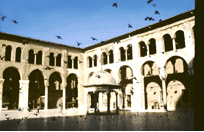
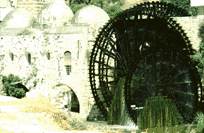
|
|
Closer
in time, it evokes the same adventure with the Image
of Lawrence of Arabia eating the grapes of
Damascus.The more that one discovers this city, the
more that one falls under its charm. On a background
of omnipresent sound, a multitude of narrow streets
modestly hiding little palaces or houses of wood
dating back to the middle-ages, not forgetting the
exuberant souks which delight our senses: so many
colors, smells and noises! It's a multi-millenium city
that one must see at least once in a life-time.
Continuously inhabited since the millenium, Damascus
is one of the oldest cities in the world. A prosperous
city from the 2nd millenium, the Aramaeans made it the
capital of a powerful kingdom until the 1st millenium.
In 732 BC, the Assyrians take possession of the city.
When Nabuchodonosor conquers Syria and Palestine in
572 BC, the country falls under the thumb of Babylon,
followed by the Achemenid Persians. After the conquest
of the country by Alexander the Great, its urbanism
and organization are designed according to the
Hellenistic plan: roads at right angles and the
building of a palace, a theatre, an agora, baths and a
temple dedicated to Zeus. In 84 BC, tired of the
quarrels with the Seleucids, the Damascenes ask the
help of Aretas, Nabatean king. Rome also interferes
and Pompei finally settle in Damascus in 64 BC. From
this moment on, Damascus takes advantage of the "PaxRomana".
Made wealthy by the restarting of commerce, the city
beautifies itself: its ramparts, ornated with seven
doors, are built at last. An aqueduct distributes
water from the Barada to the houses and to the thermal
baths of the town. The cardo, today known under the
name of "Straight Street" or "Via Recta",
appears.
Saul of Tarse, persecutor of the Christians, converts
to Christianity in Damascus and becomes Saint Paul.
In 117, the emperor Hadrian honors the city with the
title of metropole. Damascus becomes the capital of
Phoenician Syria in 195 and rises to the rank of
"colonia" in 244, thanks to the Roman
Emperor Philip the Arab.
In the course of the 3rd century, the manufacturing
industry develops (arms, textiles: cotton and silk,
glass) and during the Byzantine period, from the 4th
to the 6th century, the construction of the cathedral
of Saint John the Baptist is effectuated on the site
of the temple of Zeus. Numerous churches are also
erected, such as Saint Mary and Saint Thomas.
The
7th century witnesses several upheavals:
- In 613, the taking of Damascus by Sassanid
Persians and the deportation of its inhabitants.
- In 636, Damascus under siege for six months,
surrenders to Khaled Ibn El Walid and becomes Muslim.
- In 661, the Sultan Moawiya, founder of the Omayyad
dynasty, makes Damascus the capital of the
empire. It
remains so until 750. The Omayyad century (661-750)
corresponds to the blossoming of Islamic art of which
unfortunately remains only the famous Omayyad mosque
erected on the site of the Saint John the Baptist
Cathedral. Its plan constitutes the prototype of
the,
"so called", Arab mosque.
In 750, the Abassids drive out the Omayyads and
transfer their capital to Baghdad. In spite of this,
Damascus conserves an important regional prestige. The
Seljuqs take their turn as masters of the city
building the citadel, which, not only serves as a
royal residence, but also as a fortress. In 1154, Nour
Ed Din renders Damascus its title of capital. Saladin,
who governs it afterwards in 1174, stops the Crusaders
from taking possession. In spite of the Mongol
incursions of 1260 and 1400, the Mamelukes in power
take up the construction and the restoration of
numerous monuments. The Ottoman period, (from 16th to
the 18th century), after a period of political
instability, is marked by a commercial "renaissance";
Damascus is blossoming and getting wealthy. The houses
become more beautiful and districts, like Midan, are
created. Damascus follows the decline of the Ottoman
Empire and it's not until the19th century, that it
once again finds its splendor, thanks to Governors
Midhat Pacha and Nazem Pacha. They reorganize the city
most notably by building the districts of Marjeh, and
Mouhajerine and by enlarging the souks. These works
were completed during the French occupation from 1920
onwards.
Some
monuments to visit in Damascus:
- The Omayyad
Mosque, The Mausoleum of Saladin,
The Tekiyeh Souleymanieh and its Khan, The Church of
St Ananias, The Azem Palace, The Street called
Straight.
Other
places of interest:
- The National Museum, The Old Town, Damascus
viewed from the top of Mount Qassioun, Straight street,
The Hamidieh souk, The Nour Ed- Din hammam.
SURROUNDING
DAMASCUS
The Tomb OF Abel
Abel, assassinated by his brother Cain, was reportedly
buried on the summit of a mountain on the way to
Bloudan, about 20 Km from Damascus. A place of Druze
worship was erected on the spot to mark the tomb of
humanity's first murder victim.
The
Tomb of Sayyeda Zeinab
Here lays the fourth daughter of Ali, the
son-in-law of the prophet Mohammed. The tomb, a place
of pilgrimage for the Shiites, distinguishes itself
from other Syrian monuments by the magnificence of the
setting. It is entirely decorated with Persian style
turquoise earthenware and its dome is covered with
golden leaves.
|
Ma'alula
An impressive screen of
mountains conceals a little Christian
village with houses painted in periwinkle
blue. Its inhabitants still speak
Aramaic,
the language of Christ. One of the oldest
churches in Syria overhangs the village, the
Mar Sarkis church, where one can admire
icons dating back to the 16th and 18th
centuries.
|
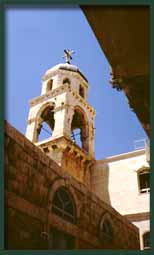
|
Seydnaya
Here one not only finds the vines of the
wine spoken of in the Bible, but also a convent built
in 547 housing one of the four icons made by the
apostle Luke featuring the Virgin Mary.
Dumeir
In 84 AD, the Nabateans built an altar here
dedicated to the Semite God Baal
Shamin. During the Roman period, the village took the
name of Thelsae. In 245
AD, Philip the Arab had the temple of Zeus Hypsistion
built here which was
fortified by the Muslims.
Yabroud
This
site, inhabited for tens of thousands
of years, belonged to Agrippa 2nd, who received it
from the emperor Claude in 53 AD. The Byzantines used
some of the elements of the temple of Jupiter to
construct a church that, today, houses a beautiful
collection of icons.
Deir
Mar Mousa (Nabeck)
Here one can admire a monastery and a
chapel dating back to the 6th century AD and abandoned
in the 17th century AD. It was probably founded by
Saint Mousa (Moses), the Ethiopian. Apart from the
frescoes realized in the 7th century AD, others
painted in the 11th century bring much charm to this
antique place of worship hidden in the Syrian
Mountains.
|
|
ALEPPO
Syria's second
city, but nonetheless
rich and cosmopolitan. Aleppo has always had an
important political and economical role. It disputes
with Damascus the title of the "the world's
oldest continuously inhabited city". The first
human community at the origin of Aleppo lived in a
place commonly known as El Maghayer, meaning "the
caves", near to Aleppo .It figures under the name
of "Halab" from the 3rd and 2nd milleniums
in the archives of Ur and of Mari. In 1780 it becomes
the capital of a prosperous but coveted kingdom: The
Yamhad, Egyptian, Babylonian and Hittite texts of the
17th century BC, also attest to the importance of this
remote age.
|
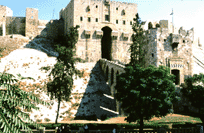
|
|
Undergoing
Hittite domination in the 17th century BC then
Mitanian domination in the 14th century BC, the city
refalls into the Hittite belt towards 1370 BC. In the
9th century BC, Aleppo is an Aramaean capital then the
Assyrians (738), the Babylonians (6th century BC) and
the Persians all take turns in conquering the city.
Re-baptized "Beroia" and constructed
according to a Hippodamian plan when the Seleucids
hellenize Syria, it remains in the shadow of Antioch,
the capital of the empire. From 64 to the 2nd century
AD, it is a Roman town. From the 4th to the 6th
century a Byzantine town, and finally from 637 a
Muslim town. Under the Abbassids, in 944, a Muslim
chief, Saif Ed Daouleh makes it the capital of the
principality of Hamdanit.
From 964, Aleppo was taken and nearly destroyed by the
emperor Nicephore Phocas. A period of troubles begins
by ending with the Bedouin dynasty of Mirdassis
(1023-1079), however, Saladin who achieves the unity
of Egypt and Syria, takes possession of Aleppo in 1183
and puts Aleppo in charge of the Jihad against the
Crusaders. His son organizes the building of the wall
of stones, which, to this day still surrounds the
citadel.
Al Zahir Ghazi orders the building of almost thirty
"Madrasa" (Koran schools), mosques (of which
the Great Mosque), "khanqas" (places for
mystics), souks, caravansary and also restores the
canalization. After an exceptionally prosperous period
under the Ayyubids, Aleppo suffers hard the
consequences of the pillages by the Mongols. The
Mamelukes take advantage of this weakness and take
possession of the town. It is not until 1516 that
Aleppo once again finds its commercial dynamism with
the Ottoman domination. From 1535, France, England and
Denmark open their counters to Aleppo, which makes the
town prosperous and cosmopolitan. In 1946, on the
creation of the Syrian Arab Republic, Aleppo returns
into the shadow of its capital, Damascus.
Some
monuments to visit in Aleppo:
The Citadel
Madrasa, Halawiyeh, and Madrasa El Firdoss
The Great Mosque.
Other
places of interest:
The Museum
The Market
The Old Town
Jdeideh, the Armenian quarter
SURROUNDING
ALEPPO
Ebla
The
site, also known under the name of Tell Mardikh, dates back to the 4th millenium BC. The
center of Ebla, the acropolis, progressively took
importance until it became the capital of a powerful
kingdom to the north of Syria. Its walls housed at
this time some 30 000 people. Between 2400 and 2250
BC, the royal palace "G" was constructed.
Ebla knew a period of glory that attracted much lust,
like when it was pillaged and burned towards 2250 BC
by Naram Sin. The town, reborn from the ashes,
restarts commercial activity and grows in spite of a
second destruction in 2000 BC. Temples and three
palaces where built. Ebla becomes politically weaker
during the Assyrian domination and in 1625 BC, the
Hittites ravage it. Ebla never recovers. Little by
little its inhabitants desert the town and it falls
into oblivion....
Maarat
En-Numan
Maarat En-Numan for a long time carried the
name of Arra. It was then a Greek-Roman town, which
was taken and destroyed by the Byzantine emperor
Nicephore Phocas in 968. In 1099, Maarat En-Numan
witnessed a terrible event that marked the Crusaders
just as much as the "Saracen" episode: On
the road to Jerusalem, the Crusaders stopped and
massacred 20 000 people. With Christmas approaching,
pushed by hunger, they committed acts of cannibalism
on the bodies. It was not until 1135 that they left
the site driven out by Zhengi the Turk. Later, the
Muslims built mosques, of which the Great Mosque, and
khans with and on top of the remnants of the old town.
To visit: The Khan Murad Pasha today converted into a
museum of Roman and Byzantine mosaics.
The
"Dead Cities"
An extraordinary
site: 700 towns spread
over a perimeter of 2 000 Km2. To qualify them as
"dead" seems displaced when one contemplates
them today. It seems, in fact, as if their inhabitants
have just left the site, so much the conservation is
exceptional, thanks to the quality of the stone. From
the 1st to 6th centuries, the region distinguished
itself by its olivaries. They were developed and
especially popular, thanks to the system of "murgasa"
Which, consists in offering a peasant some capital and
land that he must cultivate until production. Then,
the owner recuperates half of the land and the peasant
keeps the other half. From the 6th century onwards,
the Byzantine-Persian wars ruin this micro-economy.
With the Muslim conquests in the 7th century, the
villages, no longer able to trade with the Christian
West, abruptly lose their population.
|
|
Saint
-Simon
In
Arabic, "Qalaat Seman", this
site bears the name of the ascetic Saint- Simon (4th
century AD) who spent forty-two years of his life here,
isolated on the top of a column that was several times
made higher (reaching up to about 20 metres). His
reputation was such that he was known as far away as
the occident. After his death, the hill where he had
lived became a much- frequented place of pilgrimage.
In the 5th century, a "martyrium" was built:
an immense cruciform church, with in the middle, the
remains of the column of Saint-Simon. Chapels, a
monastery and a baptistery were erected around the
church, as well as "hotels" to welcome the
pilgrims.
|
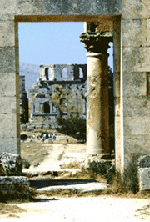
|
|
The
Byzantines occupied and fortified the site in the 10th
century before it was once again abandoned. It is to
be noted that at the foot of the hill of Saint-Simon,
a village: Deir Semaan, relayed to the monastery by a
processional road, also housed many pilgrims.
|
|
Kirkbizeh
This ancient Christian village is built
around a house dating from the 3rd century,
transformed into a church the following century. It
contains relies of one of the first martyrs. The first
Christians clandestinely celebrated their masses here
until the Edit of Milan (313).
Qalb
Lhoze
Qalb Lhoze signifies in Arabic "the
heart of an almond". Behind this charming name
lies a little village and above all a remarkable
basilica having probably served as a model for the
churches of the region. This church built towards 450
is dedicated to Saint-Michael and Saint-Gabriel.
El-Bara
El-Bara is one of the greatest "dead
cities" both in size and importance. In fact it
remained for a long time a first class center of
communication, but the prosperity of the town leant
also on a dynamic agriculture and also on the fact
that it housed an important religious center. The
Crusaders arrived here in 1023 but their presence
would be short lived: they were expulsed in 1098
following the massacres committed in Maarat En Numan.
Today, a cathedral, four churches (5th and 6th
centuries), tombs with pyramidal roofing (5th
century), wine-presses, two store houses and a rich Roman villa
(3rd century) transformed into a convent, bear witness
to the glory of this by-gone age .
Sergilla
Modest but well
conserved, this village,
apart from its private habitats and agricultural
villas, includes a necropolis, a church, thermal
baths,
wine-presses and an "androon" where the
local officials met up.
Ain
Dara
Occupied since the 1st millenium until the
time of the Seljuqs, the town became a small Aramaean
kingdom towards 1190 BC, a Neo-Hittite civilization
develops building the temple of Ishtar between the
10th and 9th century BC. Ain Dara, destroyed in the
7th century BC and rebuilt in the 4th century BC,
prospers during the Roman period then slowly withers
after the Muslim conquest.
Cyrrhus
Cyrrhus carries the name of a Macedonian
town: Cyrrhos. Capital of the Cyrrhestic,
(Province of the Seleucid kingdom), the town served as
a shield against invasions.
It was also the crossroad of the northern roads and
the home of a flourishing agriculture. Occupied from
the 2nd century AD, it served as a base for the
military campaigns carried out against the Armenians
of the north. In the 3rd century AD, its role of
caretaker of the border was appropriated by Hierapolis
(Membij). It was then twice occupied by Persians until
Theodoret of Cyr (423 to 450 AD) renovates and
fortifies it in line with his border work project
aimed at containing the Persian attacks. Thus, under
the name of Hagiopolis, the town knows a regain of
activity, especially religious: pilgrims come in great
numbers to render hommage to Saint-Cosmas and
Saint-Damian. Troubles disrupt northern Syria in the
6th and 7th centuries resulting in a reduction of
activity that only accentuates under the successive
dominations (Latin, Armenian and Arab), until the 13th
century when Cyrrhus falls into oblivion.
Membij
Under the name of
Hierapolis, its fame
spreads over the Roman Empire, hellenized by Seleucos
Nicator during the 3rd century BC, the town developed
around the Atargatis cult, (the Mesopotamanian goddess),
at Atargatis and at Haddad. A local dynasty "sponsored"
this cult during the Persian period so successfully
that Hierapolis became the most important religious
center in Syria. This popularity only became greater
when the Emperor Heraclius came to the town in search
of the 'True Cross" that was stolen by the
Persians during the pillaging of Jerusalem in 614 AD.
The Muslims and the Zengids succeeded one another
(11th and 12th centuries AD), the Crusaders made raids
in 1110, 1119 and 1124, and finally Nur Ed Din built a
"Madrasa" in the town in 1156.
Halabiye
- Zenobia
Previously a Roman garrison town bearing
the name of Birtha, it took the name of Zenobia (a
tribute to the Queen of Palmyra), after the victory of
Odenathus over the Persians in 270 AD. During the 3rd
century Diocletian reestablished the limes and
fortified Zenobia. Justinian restored the town in the
4th century and later the Arabs constructed a fortress.
Zalabiye
The town is opposite
Halabiye, on the other
side of the Euphrates. In fact, these two towns are
situated at the most-narrow point of the Euphrates.
The function of Zalabiye was to control the river and
to assist the pilgrims visiting the tomb of Saint-
Serge in Rassafa. Zalabiye was largely destroyed
because of an earthquake, erosion and the re-use of
some of the stones for the ballast of the railway.
Rassafa
Even though already known at the time of
the Assyrians and cited in the Bible, Rassafa only had
its glory from the Byzantine period when it became an
important center of pilgrimage. Sergius, a Roman
soldier converted to Christianity, and who according
to the legend, was decapitated for refusing to make a
sacrifice in the honor of Jupiter, became a martyr and
a saint. He gave his name to the town: Sergiopolis
(5th century). Justinian improved the fortifications
of the town in the 6th century, an act that did not
stop the Persians from possessing it the following
century. Hisham, an Omayyad Caliph from the 8th
century, restored the town and adorned it with a
palace and.a burial- place! Later, the town suffered
pillages committed by the Abassids, an earthquake and
the deportation of its inhabitants to Hama by the
Sultan Baybars. The Mongols finished making Rassafa
what we call today a "dead city".
|
|
PALMYRA
What
surprise, but also what delight to
discover after hours of driving through an immense
rocky expanse, the drop of water, the- pearl in the
desert. Magnificent remnants lost in the middle of the
desert, this oasis never fails to make one dream.
People from all over the world come to admire the sun
go down on this large village that once,
|
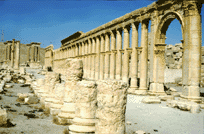
|
|
the
capital of an empire, made Rome tremble. Its name,
Tadmor, appears for the first time in the Mesopotamian
texts dating back to the 2nd millenium BC. The Greeks
made it a town organized according to Hellenistic
conceptions and re-baptized it Palmyra. Tribes of
various origins (Aramaeans, Iranians, Arabs,
Phenicians, etc..) at that time, constituted the
essential of the population (3rd century BC), until 64
BC when Pompei installs himself in Syria.Under Tibere
(from 14 to 37 AD), the site is definitively
controlled by Rome. Palmyra, profiting under the
"Pax Romana" and perceiving "customs
duty" for all products imported into its empire
and transiting through the town (obligatory stop-over
on the silk road), becomes considerably more wealthy.
The emperor Adrian, visiting in 129 AD gives back
Palmyra its status of a free town. The town therefore
receives taxes from Rome and in doing so becomes even
richer. The majority of the monuments that can still
be admired today date from this period: The temple of
Baal Shamin, The Agora, The Great Colonnade. In 212
AD, Caracalla (of Syrian origin) allows Palmyra to
attain the title of "colonia" or colony of
the Roman Empire.
Its role extends to the defense of the "limes"
against the threats of the Persians.The weakening of
the Roman empire shows in the fact that Palmyra
progressively manages to widen its zone of influence,
but this success displeases its leaders. After an
audacious victory over the Persians in 260, the King
Odenat proclaims himself the "King of
Kings".
Assassinated, his famous widow, Zenobia, pushes their
son, Wahaballat, onto the throne and in his name
throws herself into reckless conquests. Finding
herself at the head of an empire stretching from Egypt
to Anatoly, she embodies a challenge for Rome, who
reacts in the person of Aurelian. In 271, Palmyra
being under siege submits, but Zenobia flees. She is
captured as she prepares to cross the Euphrates and
was probably taken to Rome.
Her end remains uncertain. Two years later, following
a rebellion by its inhabitants, Palmyra is pillaged
and destroyed, with its people massacred by Aurelian.
Palmyra never again finds its past splendor. The
remnants of churches and the mention of a Palmyran
bishop in the list of priests present at the Council
of Nicee (325 AD) attest to an occupation of the town
during the Byzantine period. In the 17th century AD,
the Druze Emir Fakhr Ed Din builds a castle hanging
over the site of Palmyra: it is often spoken of as
"the Arab Castle". In becoming Muslim,
Palmyra retakes her old name of Tadmor. The stones of
numerous edifices are re-used in the construction of
private habitats and in 1132,
The temple of Bel was transformed into a fortress and
the "cella"into a mosque.
Monuments
to visit in Palmyra:
The Temple of
Bel, The Great Colonnade, The Temple
of Nabu, The Thermal Baths,
The Agora, The Tetrapyles, The Theatre, The Temple of
Baal Shamin, The Funeral temple, The Tombs.
Also
to visit:
The
museum, The dried out sulfuric water spring of
Afqa, and The- quarry (where the stones of the columns
were cut.)
SURROUNDING
PALMYRA
The Castle Qasr El-Hir Ash-Sharqi
It was constructed in 728 AD, during the Omayyad
period, under the reign of the Caliph Hisham. Over the
850 hectares of ground in the surrounding area,
limited by a wall of bricks of twenty-two kilometers,
agriculture was made possible, thanks to an irrigation
system. This desert observation post constituted a
place of rest where one hunted for leisure. It also
allowed the control of the traffic of goods coming
from Persia. The Abbasids also occupied it before it
became definitively abandoned after the Mongol
invasions (13th century AD).
|
|
The
Castle Qasr El-Hir Al-Gharbi
The Palmyrans were the first to establish
themselves on this site in the 1st century AD, but it
was abandoned after their revolt in 273 AD. The
Byzantines and their local ally, the tribe of the
Ghassanides, recuperated the site in 559 AD and built
a monastery here. The Omayyad Caliphs, natives of the
Arabian desert, made of it a place of relaxation and
leisure and built a hunting "lodge" (the
initiative of Caliph Hisham in 727 AD).
|
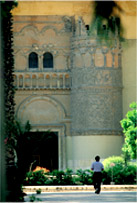
|
|
In
practice, the castle served to consolidate their ties
with the tribes and affirm their position at the
limits of the kingdom. The Ayyubids and the Mamelukes
occupied the site until the Mongol invasion after
which the site was deserted.
|
|
BOSRA
Bosra is situated on a basaltic plateau
in the heart of the fertile region of the Hauran. Its
black rocks, employed in construction for many
centuries, give much originality to the entire
region. Moreover, the solidness of the basalt has allowed the
erected monuments to face admirably the ravages of
time.
|
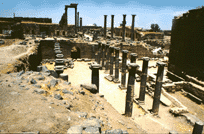
|
|
Mentioned
for the first time in the Egyptian archives in 1350
BC, under the name of Busrana, the town seriously
develops from the 2nd century BC. It becomes the
regional capital of the Nabatean, a title that will be
officially awarded to it in the 1st century BC under
Rabbel 2. In 106 AD, Trajan annexes the Nabatean and
chooses Bosra as the capital of the "Provincia
Arabia", Situated on the principal axe of
communication, the "Via Nova Trajana"
imposes itself as the obligatory point of passage and
no less than 5 000 Roman soldiers install themselves
there. With bigger and more beautiful public edifices
organized around a "cardo" and a "decumanus",
the town is re-baptized "Nova Trajana Bostra"
by Trajan between 98 and 117 AD and during the same
century, a large theatre seating 17 000 is built,
remaining practically intact to this day. From the
beginning of the 3rd century AD, Christianity, in its
moment of great expansion, changes the urban landscape:
numerous churches and a cathedral dedicated to the
saints Sergius, Bacchus and Leonce are built. A Roman
basilica is transformed into a church called the
Convent of Bahira, the Monk This monk, reputed in
Islam, recognized in the child Mohammed, the future
prophet.
After the Muslim conquest of Bosra in 632, the region
serves as a battle- field for the Muslims and the
Byzantines who fight for the control of Syria.
Thirty-six mosques, of
Which the El Omar Mosque, are constructed and many
Christians convert to Islam. The Seldjuqs, governing
the town from the end of the 11th century AD
reestablish prosperity and protect the town from the
Crusaders. Fortified by Nour Ed Din, the Ayyubids make
an authentic citadel out of the Roman theatre which
was later conquered by the Mongols. Baybars restores
it in 1261. The road leading to Mecca being modified (partly
due to the raging brigand- ages in the Hauran),
Bosra's importance declines to such an extent that it
becomes a mere village. This agricultural region,
traditionally prosperous, only really recuperates its
activity from 1886 when thousands of Druzes install
themselves in Bosra.
|
|
SURROUNDING
BOSRA
Sweida
In spite of the fact that the antique
village is actually concealed under modern
constructions, one can still visit superb mosaics and
sculptures exposed in the town's museum and admire the
four columns of the Nabatean temple as well as the
remains of a
Large basilica, dating back to the 4th century AD.
Qanawat
Qanawat was founded towards the 1st century
BC. Its name is mentioned in the Bible when, under the
reign of Herod Agrippa, the region was victim of
bandits. It then became a region of conflict between
the Nabateans and the Jewish Kingdom. Town of the
Decapolis from the time of Pompei until the beginning
of the 2nd century AD, Septimus
Severus gives it the name of "Septima Canatha"
and of Syrian "Provincia". The town attains
the level of "Provincia Arabia". Before the
town falls into the hands of the Muslims in 637,
Christianity develops (4th and 5th century AD), and
two basilicas were erected as well as a collection of
buildings called "serail", a Byzantine
religious complex built around an "atrium".
Shahba
First Hellenistic until the 4th century BC,
then Nabatean to the 1st century AD, Shahba transforms
itself into a model Roman town.
In 244 AD, Philip the Arab, descendent of this small
village, becomes Roman emperor and decides to
reorganize its city-plan. He decorates the town with
new monuments (triumphal arch, theatre, thermal baths,
palaces, agoras, temples, etc.) and re-baptizes it
Philippopolis. It is to be noted that four frescoes of
great beauty (4th century AD) found "in situ"
are exposed in the town's museum.
Ezraa
Here one finds a Greek Orthodox Church that
figures amongst the oldest still in use in Syria.
Erected in 515 AD on the site of an ancient temple, it
is the oldest basilica in the world built according to
an octagonal plan and crowned with a dome. Two hundred
meters away, one finds a second church (Greek Catholic)
called the Church of Saint-Elias dating from 542 AD.
It is cruciform and east- west oriented. Originally
its dome was made of wood. Still in the region, one
can visit the remnants of habitats dating back to the
Roman period.
Deraa
Today the capital of "Mohafazat"
(administrative region), Deraa has an antique theatre
and the Al Omar Mosque.Lawrence of Arabia was made
prisoner here by a Turkish garrison during an
intelligence mission in 1918.
Salkhad
If one refers to the geographer Abo Il Fida
(16th century AD), Salkhad was the last town before
the desert on the track to Baghdad. In 1073, the
Fatimids built a fortress and in 1214 - 1247 the
Ayyubid citadel was constructed on the crater of a
volcano, the cone making up an exterior defense. It
allowed the region to the south of Damascus to be
protected from possible attacks from the Crusaders
present in Jerusalem. This stronghold was renovated in
1277 by the Mameluke sultan Baybars. After the Ottoman
occupation, the town was abandoned and fell into
oblivion until the last century when Druzes from
Lebanon found refuge here.
|
|
|
|
THE
EUPHRATES ' VALLEY
Dura
Europos, 'The Pompei of the Syrian Desert".
Founded in 303 BC by Nicator, a general of Seleucos 1, on the
site of an Assyrian fortress named Dawara, the town becomes
Dura, meaning fortress in the ancient semite language, and
Europos in memory of the birthplace of Seleucos 1 Nicator in
Macedonia. Dura Europos, designed to welcome Greek and
Assyrian settlers, was also part of a network of military
colonies that secured control of the central region of the
Euphrates. The town organized itself like a draught-board
according to a Hippodamian plan, housing blocks of 35 by 70
meters, including 8 houses, separated by perpendicular
streets.
The palace and the temples were to the south of the town. By
the 2nd century BC, the town had enlarged. After the
Seleucides, the Parths were the new masters for a period of
approximately three centuries starting from 113 BC. Previously
defensive, the town becomes residential and
Commercial with a population more and more cosmopolitan:
Iranians and Semites joining the Greeks. In the 2nd century
BC, the region of the Euphrates falls under Roman control.
From this period, only the triumphal arch and the Roman
citadel remain. In 161 AD, an earthquake seriously damages the
town but not destroying it as in 212 AD. It receives the
honorable title of "Colonia Romana". Due to the
threat posed by the Sassanides, the site was fortified:
reinforcement soldiers arrive and among them Palmyran peasants.
The
latter is responsible for the construction of the temple of
Bel. Many other places of worship were built here: temples,
Christian chapels, synagogues decorated with frescoes, all
bearing witness not only to the religious fervor of the town's
inhabitants but also to their cosmopolitanism and their
tolerance. In the 3rd century, the town and its walls are
pulled down and the site becomes definitively abandoned.
Raqqa
Legends would have us believe
that, Raqqa was
founded by Alexander The Great. In reality it was Seleucos 1st
Callinicos (244 - 242 BC) who was at the origin. Called
Nicephorium during the Hellenic period, it was baptized
Callinicum by the Romans. The Byzantines made a defensive
fortress of it in reply to the danger of a Persian attack, but
apparently it was not- enough as the soldiers of Justinius
were defeated when up against the Sassanides.
The town became Muslim in 639 AD gaining much splendor: The
Caliph Hisham had two palaces built and the Abbassid Caliph,
Al Mansour, restored the town in 754 AD before making it his
second capital. Its strategic position allowed it to protect
Byzance and Baghdad. More beautiful and prosperous than ever,
the town attracted Caliph Haroun Al Rachid who established his
summer residence here and gave it a new name: Al Rafiqa. A
program of construction was put in place in order to
strengthen the town and made of it a symbol of Abbassid
hegemony. The Mongol invasion of 1258 AD puts a final term to
this age of glory.
Mari
Mari was founded in the 3rd millenium BC in order
to control the river and caravan traffic from which the town
perceived taxes. Between 2000 and 2340 BC, Mari which
dominated the whole of the Mesopotamia, is at its apogee but
must give a tax to Ebla. This richness makes many envious and
among them Sargon of Akkad to whom one attributes the
destruction of the town in 2340 BC. At the end of the 3rd
millenium, the kings of Ur stretch their suzerainty over
Mari.
From 2100 BC to 1800 BC, the "Shakkanak" govern, the
town depends upon Akkad. The 18th century BC is marked by the
glorious reign of Zamri Lim who built a palace of 300 richly
decorated rooms, serving as an active political, economical,
and administrative center. After the Assyrian occupation (1800
BC) and a brief period of independence (1775 to 1760 BC), Mari
is destroyed by Hammurabi in 1758 BC.
|
THE
COAST
The Crac des Chevaliers
The
strategic value of this place has been known for
thousands of years: the Egyptians went into battle
here against the kingdom of Mitanni then against the
Hittites in the 15th and 13th centuries. In 1031 AD,
a Kurdish emir built the first fortress "Hosn
El Akrad" or The "Fortress of the Kurds".
|

|
|
Raymond
of Saint-Gilles and his troops drove them out in
1099 AD. However, it is not until 1110 that the
French Crusaders, thanks to Tancarade, decide to
install themselves and build a fortress,
systematically restored after each Muslim assault.
These works were interrupted in 1271, when the
sultan Baybars takes possession of this stronghold
that had already resisted Nour Ed Din, Saladin, and
Adel Abou Baker. The Crac was in between time sold
to the "Hospitaliers" (monk-soldiers) in
1142 by Raymond 2, the count of Tripoli. The chapels
converted into Mosques and the Latin inscriptions
erased, the site served for a long time as a
military base from where the war against the
Crusaders was led and later the Muslim village
people made it their home. They weren't evacuated
from the fortress until 1934.
|
Safita
The village is constructed around the
citadel:
"Castel Blanc". It is mentioned in the Arabic
archives as being the property of the count of Tripoli in 1112
AD. The first fortress was, mostly, destroyed by Nour Ed Din.
Later, the Templars, in charge of the defense of the
region,
rebuilt and fortified it. "Castel Blanc" fell into
the hands of the Baybars in 1271, just before the latter took
possession of the Crac des Chevaliers.
Amrit
Occupied from the 3rd millenium BC, the site took
the name of Marathos during the antiquity. At the time of the
Persians, when the nearby island of Arwad was Phoenician
Capital called Arados, Amrit was its continental suburb. In
the 1st millenium, it was at its pinnacle as later following
the conquest of Syria by Alexander the Great in 333 BC.
Marathos begins to decline, finally being abandoned in the 2nd
century AD. One can still admire today the hypogeum tombs and
a very beautiful temple: Ma'abed, from the Persian period (between
6th and 4th century BC).
Arwad
This small island with a sultry past is the same
one that is cited in Genesis in the Bible. The presence of a
stream of fresh water favored the human occupation of the area
from very early on and allowed it to resist several very long
sieges. Originally, (a Canaanite urban center), the island is
taken by the Pharaoh Touthmes 3rd, during his fifth campaign
in Syria. The Phoenicians used it as a coastal population base,
and the Assyrians and the Achemenid Persians invested it also.
In 333 BC, Gerostratos, the king of Arwad hurries to put his
kingdom at the disposition of the Seleucid invader, an act
that allows Arwad to maintain a certain amount of independence.
Its influence lessens simultaneously with the rise in power of
Tartous, another near continentaly town. The island becomes a
museum-town. Saint- Paul stopped here during his journey to
Rome. A Byzantine naval base, Arwad falls under Arab
domination in 460 and finally the Templars occupied it until
the massacre of the last troops of the Crusaders in 1302.
Tartous
Under the name of Antirados
(Anti-Rados: opposite Arwad), it allowed the Phoenicians to make the liaison with
Arwad. It took the name of Tortose under the French
Crusaders,
and when the freedom of worship was accorded to the first
Christians, pilgrims came here in great numbers to visit the
first church consecrated to Mary (by Saint-Peter himself
according to the legend). Raymond of Saint- Gilles took
Tortose in 1102 and then the French Crusaders decided to erect
the cathedral of "Our Lady of Tortose" on the same-
spot as the first church in 1123 AD. Towards 1165, the
Templars kept the fortress and resisted to the assaults of
Saladin in 1188. But Saladin, as the Baybars would later do
when unable to capture the fortress, destroyed the town.
Tortose finally fell into the hands of the Muslims in 1291.
Afterwards, the cathedral knew several transformations: into a
mosque, Turkish military barracks, and then into a museum in
1956.
Misyaf
In the 12th
century, a system of fortresses was put
in place, by the Ismaelians in order to escape the
persecutions from the orthodox Sunnite regimes of Aleppo and
Damascus. The fortress of Misyaf, therefore, had a defensive
role during the Seleucid, Roman and Byzantine periods before
falling under the control of the Crusaders in 1103. In 1140,
Ismaelians, who made of it (for more than two centuries) the
center of their sect, led by the famous "old man from the
mountains", took the fortress.
Saladin
who had already escaped two assassination attempts conducted
by the sect, besieged Misyaf in 1176 but later gave up. A
century later, the Sultan Baybars became the master of the
site.
Qalaat
Marqab
Built in 1062 by Muslims, the "Look-Out Castle"
passed over to the Byzantines in 1104 and to the French
Crusaders during its surrender to Roger of Antioch. The order
of the "Hospitaliers" made the fortress bigger in
order to make an impregnable stronghold [end 12th century)
which suffered the attacks of the Arabs after Crac des
Chevaliers had fallen into the hands of the latter. After five
months of siege, the sultan Qalaoun took over the stronghold,
which in turn served in the struggle against the Crusaders. A
village developed "intra-muros" then the site fell
into oblivion towards the 19th century.
Jableh
This small town of the province houses the remnants
of a Roman theatre which in the past could hold up to 6 000
people. Jableh firstly served as a port from the time of the
Phoenicians until the present day. Integrated into the
Assyrian empire, it was the head of a Greek colony of the 8th
century BC, and above all belonging to the group of Phoenician
sites controlled by Arwad during the Persian and Seleucid
periods. The town was Roman, a Byzantine bishopric then Arab
in 638. In 1109, when Jableh was incorporated into the
Principality of the Antioch, the Roman theatre was transformed
into a Crusader's castle. Taken by Saladin in 1188, it was
briefly abandoned, the returning Crusaders and the occupying
"Hospitaliers", arguing the ownership with the
Templars. In taking it over, the Mameluke sultan Qalaoun puts
an end to this dispute.
Lattakia
Originally a small Phoenician
village, the Assyrians, the Persians, then the Seleucids took turns in
conquering it. Lattakia, becoming Laodicee, had an important
role in the Kingdom of Seleucos 1st Nicator (311 - 281 BC);
the first harbor that works and a large producer of wine. At
the IInd century. Septime Severe, prefering it to Antioch
named Lattakia the capital of Syria. He had numerous works of
enlargement and renovation carried out like the construction
of four colonnaded roads, but the conquests, which followed
and above all the successive earthquakes of 494 and 555,
destroyed these improvements. Justinian rebuilds the town. The
Byzantines, the Turks, the Crusaders and finally Saladin in
1188, conquered the town. Pillaged and burnt by the Chypriot
Crusaders, Lattakia lost its importance with the passing of
time. At the beginning of this century it was only a simple
fishermen's village. When Syria lost Antioch, the port was
reborn and prosperity returned.
Ugarit
The
site, called Ras Shamra in Arabic, goes
back to the 7th millennium BC. The period during the 2nd
millennium BC was of important urban expansion of which the
discovery of houses, funeral caves, two temples dedicated to
Dagan and Baal and a Palace (15th
BC) are proof. The
construction of a royal palace and new living areas made the
town a real urban agglomeration. An important intellectual
center, a type of cuneiform writing was invented here, the
world's first alphabet. Following significant advancements in
navigation and commerce, due to the excellent relations with
the Egyptians, the town, richer, adorns itself with new homes
and the palace is enlarged in the 14th and 13th century BC.
Falling under Hittite occupation, the town was obliged to pay
an annual contribution. Ugarit was destroyed by the arrival of
the "People of the Sea" and disappeared towards 1180
BC.
The
Castle of Saladin
In the 1st millennium BC, the Phoenicians erected a
fortress that was captured by Alexander the Great, the
Byzantines, and finally the Crusaders in 1108. The latter
erected a large rampart and dug a hole in the rocks
surrounding their greatest Syrian possession, which the
Muslims took over in 1188 and which became the Castle of Salah
Ed Din, or Saladin. The same year the Mamelukes occupied it.
When peace returned to the region, it was abandoned in favor
of more comfortable habitats.
THE VALLEY OF THE ORONTES
Homs
Today capital of Mohafazat (administrative region)
and first industrial and agricultural town of Syria, it was
known in the past under the name of Emese where the empresses
Julia Domna, Julia Maesa, Julla Mammea and Julia Soemia were
born. In the 4th century BC, head of a bishopric, an important
Christian community developed. Catacombs, decorated with
mosaics, were found here. Later, the town, suffering the
pillages and fires of the successive conquerors, saw its
archaeological patrimony dry up.
|
Hama
Fifth town of
Syria, one often qualifies
Hama as traditionalist due to its religious
conservatism but also romantic with its norias, huge
wheels of wood that have not stopped turning since
the 14th century. As small Aramaean town, it was
annexed by the Assyrians in 820 BC. Few monuments
resisted the successive occupations, Seleucid,
Roman, Byzantine, and the Arab empires.
|

|
|
The
Seleucides gave it the name of Epiphania in honor of
Antiochos 4th Epiphania, their leader. Situated
practically at the halfway point between Aleppo and
Damascus, Hama was often the object of territorial
quarrels between the rival dynasties of Aleppo and
Damscus, especially during the very agitated 11th
and 12th centuries. The first norias were
constructed during the Ayyubid period, a period of
great prosperity. The Mamelukes and the Ottomans
followed the example. Saladdin developped here an
orthodox Sunnism that one finds today in the sharp
traditionalism of its inhabitants.
|
|
Aphamea
Aphamea is one of the four towns
(The Tetrapolis) founded by Seleucos 1st Nicator at the
beginning of the 3rd century BC, but the human
occupation of the site goes back to Neolithic times.
Hellenized at the end of 5th century BC, it was
firstly rebaptized Pharnake then Pella after the
conquest of Alexander in 333 BC. In 64 BC, Syria
became Roman. The citadel of Aphamea was destroyed
but the town continued to prosper as a military base
until 2nd century AD, when the construction of the
remnants that one can today admire was started:
|
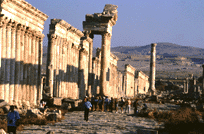
|
|
a
colonnade surrounded by public monuments such as the
thermal baths, a theatre, temples and villas.
Following several earthquakes in 115, Trajan ordered
the restoration of the town. As for the colonnade of
the principal highway, it was completed under the
reign of Marc Aurelius. Apart from its economic
importance, Aphamea became the center of a school of
neo-platonic philosophy that particularly bloomed in
the 4th century. During the Byzantine period, it was
also the home of the adepts of the "mono-physical
doctrine " and provincial capital, head of a
bishopric in the 5th century. Before the Persians
occupied it in 573, they pillaged and burnt it.
Passing between the hands of the Byzantines and the
Arabs, it was bought from the principality of
Antioch by the Crusaders until 1149, when Nour Ed
Din took possession. Finally a huge earthquake
(1157) destroyed the town, limiting the human
settlement to the citadel.
The caravansary and the mosque from the 16th century
illustrate the role later played by the town as a
resting-place on the way to Mecca.
|
The
Castle of Sheizar
Situated at a passage point on the
Orontes, the
castle was founded by a regiment of the army of Alexander the
Great. Held by the Byzantines during a hundred-year or so, it
fell into the hands of Arabs who made of it an important base
of resistance against the Crusaders. The latter tried numerous
times to take possession, in vain. Earthquakes associated with
the succession of different Arab and Mongol dynasties
seriously damaged it. Baybars and his successor Qalaoun
reconstructed it.
The
Castle Ibn Wardan
Undoubtedly, one of the most beautiful from the
archaeological point of view, the fortress was constructed
under the care of Justinius during his last reigning year (564
AD). The complex, palace, church, military huts, was destined
to control the nomad Arab population rather than to ward off
the threat of a Persian invasion.
|

